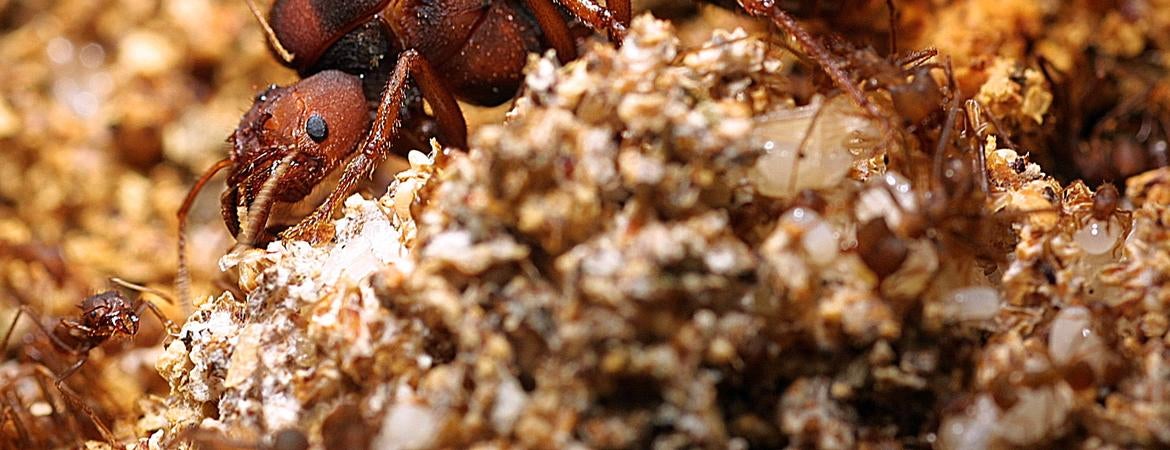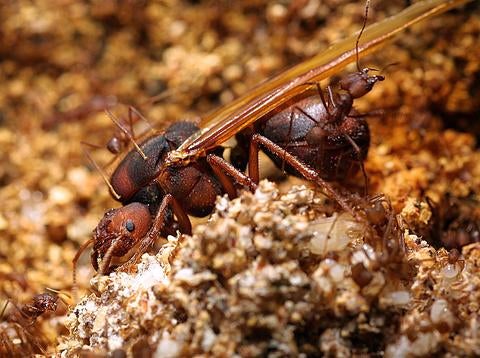
It’s hidden from sight, but there’s an epic battle of the sexes raging in the leafcutter ant species Atta colombica. Competing males deliver sperm in a fluid that’s toxic to rivals’ sperm, while females quash their efforts in order to ensure their own reproductive success.
For the first time, a team of researchers led by Boris Baer, a professor of entomology at UC Riverside, has begun to untangle the molecular mechanism underlying this biological battle. A study describing the research was published online in Molecular & Cellular Proteomics.
Leafcutter ants are unusual in the realm of social insects because their queens are polyandrous, meaning they mate with more than one male. This happens just once in a queen’s lifetime when a winged virgin female hatches and takes to the sky for an intense mating period called the nuptial flight.
Intent on producing offspring, males compete during this period by delivering sperm to queens in a fluid laced with ingredients that are harmful to competitors’ sperm. But queens have a different agenda: they must return from their nuptial flight with enough healthy sperm to supply their entire reproductive future, which may span 20-30 years and result in mega societies of several million worker ants.
“After the nuptial flight, the males die and the queens shed their wings, burrow into the ground and start their colony,” Baer said. “The queen will use the sperm she’s collected in her sperm storage organ for the rest of her life. If she runs out she will lose her fertility and the whole colony will be doomed.”
Such male-female rivalry, called sexual conflict, occurs when two sexes have competing interests concerning reproduction. In birds and mammals, sexual conflicts manifest as a set of behaviors or appearances, but in leafcutter ants the war is waged out of sight, within the queen’s sperm storage organ.
When males inseminate the queen, their sperm are delivered in a seminal fluid that is packed with proteins, some of which are known to damage rival sperm. The queen produces a secretion that prevents this damage—but how does it work? To understand the process, Baer’s team studied what happens on the molecular level.
Using ants collected at the Smithsonian Tropical Research Institute in Gomboa, Panama, the team used artificial insemination experiments combined with proteomics (the study of an animal’s entire set of proteins) to identify changes to the male’s seminal fluid that occur after exposure to the queen’s spermathecal secretion. They showed that the queen’s secretion degrades seven proteins in male seminal fluid. Additional studies confirmed that these proteins are involved in damaging rival sperm.
“There is a huge amount of literature about sexual conflict across a multitude of species, but very little evidence about how this works at the molecular level, which makes our study very exciting,” said Ryan Dosselli, a postdoctoral researcher at the University of Western Australia who conducted many of the experiments. “By narrowing down the list of candidate effectors to just a handful of proteins, our work paves the way to full characterization of the molecular mechanisms of sexual conflict. And, while our findings are limited to leafcutter ants, similar processes likely exist in other social insects and this research improves our understanding of the mechanisms controlling reproduction in many species.”
Baer said the fact that only a handful of proteins in male seminal fluid are responsible for incapacitating rival sperm suggests the process is very specific. Future studies will explore how these proteins distinguish between “self” and “non-self” sperm to prevent a male from damaging his own sperm.
The title of the paper is “Protein-Level Interactions as Mediators of Sexual Conflict in Ants.” In addition to Baer and Dosselli, authors were: Julia Grassl, Suzanne den Boer, Madlen Kratz and Jessica Moran from the University of Western Australia, and Jacobus Boomsma from the University of Copenhagen.




